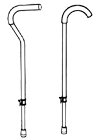Advance Care Program: Mobility
CANES & QUAD CANES
 PURPOSE: Walking aids are designed to give the user additional stability when used properly. Your physician has ordered your walking aid for a specific reason. If your physician has given you specific instructions, you must follow them.
PURPOSE: Walking aids are designed to give the user additional stability when used properly. Your physician has ordered your walking aid for a specific reason. If your physician has given you specific instructions, you must follow them.
TYPES: There are many different types of canes, wood, aluminum, folding, and adjustable are just some of the types. Medical supply companies maintain a modest inventory of most types. If there is a special need, please let them know and they will try to order it. Most canes can only support weights of up to 300 pounds. If a heavier duty cane is needed, please notify them.
FITTING: A properly fitted cane or walking aid is adjusted to the height necessary when wearing shoes you will be wearing while walking with the cane or walking aid. The top curve or handle should be approximately at the hip joint and the elbow will be slightly bent (20 - 30 degree angle). For wooden canes the shaft must be cut approximately ¾ inches short to accommodate the rubber tip.
USE: The cane, or walking aid, is held in the non-affected or good hand. Stand with your legs slightly apart and the non-affected leg slightly behind the affected leg. The cane or walking aid should be placed approximately 12 inches in front and on the side of the non-affected leg. Your first step is with the non-affected leg. Then the weak or affected leg moves forward while the cane is firmly held to the floor. Your physician or therapist may specify changes to this basic technique. When using a quad cane the base needs to be turned so that the narrow or flush side is faced toward the body. Never negotiate stairs without consulting your physician.
When utilizing your walking aid for assistance in standing from a seated position, both feet should be firmly planted on the floor. The walking aid must be in your good hand. Push up on the armrests to a standing position.
SAFETY: Use extra caution for mobility risks and risks of falling, including:
- Poor lighting: Use of nightlights, flashlight by bedside, lamps or light switch that can be reached easily.
- Poor walk spaces: Fix loose floorboards, paint uneven floors, use wet floors signs, keep snow and ice cleared from entrances, ensure carpet is firmly attached to the stairs, do not walking in stocking feet, and remove loose rugs, clutter, cords, and excess oxygen tubing.
- Equipment: Replace worn or cracked walker, crutch, and cane tips, use colored oxygen tubing on light carpet, and tighten loose handrails.
- Bathroom: Install grab bars, use bath mats with suction cups, and use elevated toilet seat.
- Medications: Be aware of medications that may cause dizziness, drowsiness, and unsteadiness.
MAINTENANCE: The rubber tips on your walking aid are very important and you should inspect them regularly. Worn or damaged tips must be replaced immediately. Medical supply companies maintain a wide variety of cane tips that are inexpensive. The handgrip should be checked for movement, if applicable, on a regular basis and replaced if damaged. Wood canes should be stored in a cool, dry place to prevent damage.
More Mobility Topics
Canes & Quad Canes
Crutches
Walkers
Bath Benches & Safety Rails
Commodes
Grab Bars



